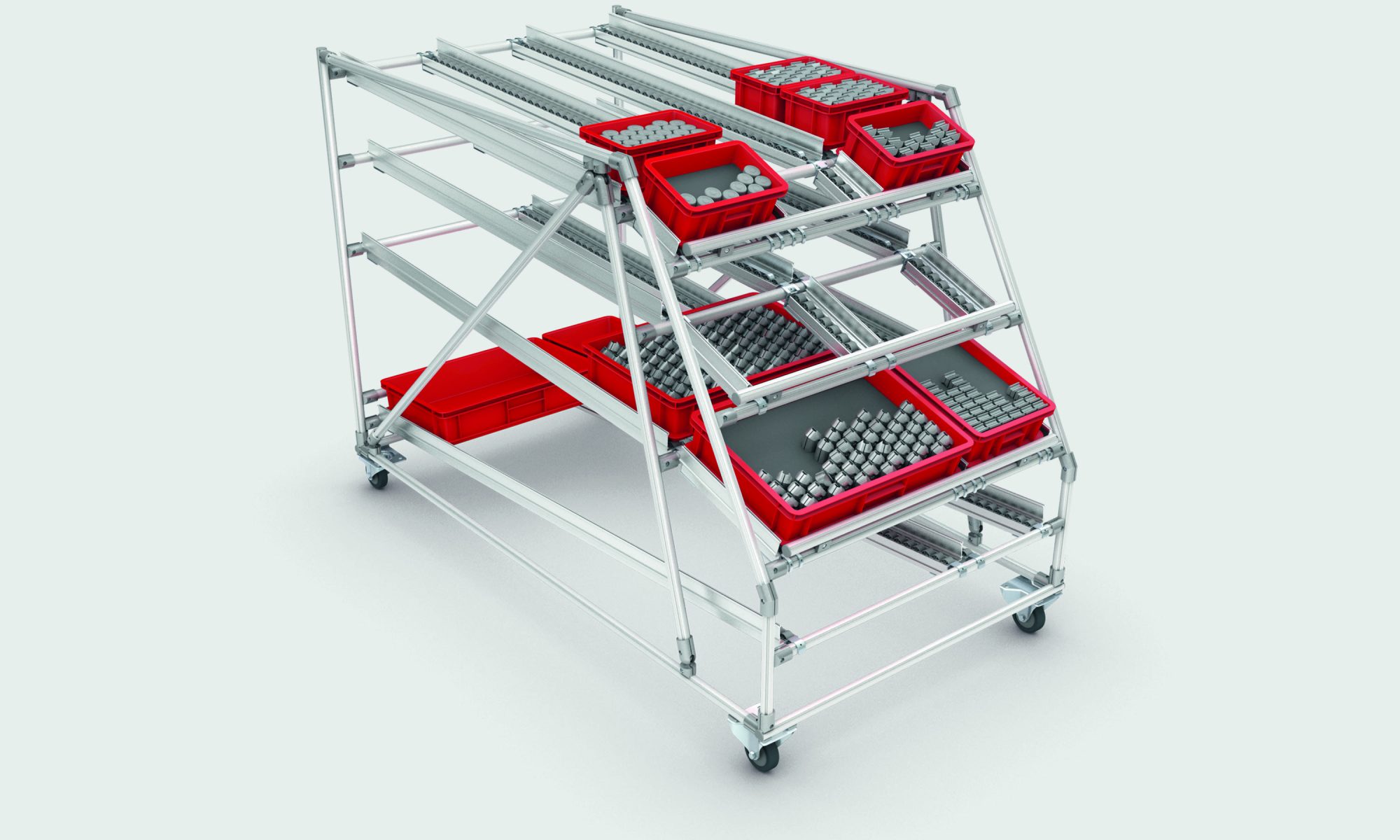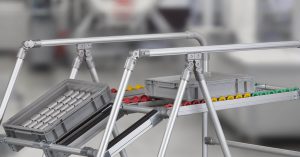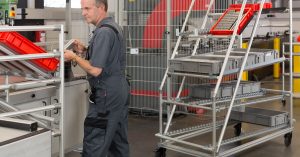The 7 Muda are widely known, but they aren’t the only types of waste in production.
The Toyota Production System (TPS) that emerged in the 1950s is thought to be the nucleus of lean production. To this very day, Toyota has had its sights firmly set on reducing lead times. A quote from Taiichi Ohno, the founding father of the TPS and thus to a certain extent lean production, clearly illustrates this: “All we are doing is looking at the time line, from the moment the customer gives us an order to the point when we collect the cash. And we are reducing the time line by reducing the non-value adding wastes.”
In lean terminology, these non-value adding types of waste that increase lead time are known as Mura (“imbalance”), Muri (“overloading”) and Muda (“waste”). As they all start with “M” and are all closely connected, they have been dubbed the “3M”. By the way, they are also identical to the three factors in the Kingman Formulathat negatively influence lead time. Although companies often concentrate on Muda, the most important of the three Ms is actually Mura.
Mura and Muri skew the balance in production
How should we interpret “imbalance” in the context of lean production? As usual, it helps to take a look at what actually happens on the shop floor and focus on the Gemba – the place where value is actually added. A typical example of Mura is when a company overloads one resource (i.e. a case of Muri) whilst barely utilising another, if it at all. Even where there is just one resource, it is not uncommon to find this kind of interplay between overloading and insufficient utilisation. When Mura occurs, it generates two types of losses. On the one hand, queues start to build up upstream of the overloaded station and these significantly hamper productivity. On the other, failing to use capacity to its full potential also contributes to a loss of added value. All in all, this reveals weaknesses in coordinating the individual processes.
Such a lack of harmony in process coordination is a typical cause of overloading, also known as Muri. This can have a considerable impact on employees, with excessive psychological pressure and harsh physical strain quickly taking their toll – particularly if ergonomic principles have been ignored. But it’s not just staff that are affected – working materials also take a hit. Besides short-sighted planning, unclear work instructions and communication problems can create a breeding ground for Muri. The just-in-time principle has become a tried-and-tested measure for counteracting overproduction. The underlying idea is that material is only delivered and processed if there is an actual need to do so, which first and foremost prevents the build-up of high stock levels.

7 Muda – actively combating waste
The 7 Muda are one of the best-known and clearest lean concepts, but by no means should they be underestimated (we’ll explain further in just a second). Muda translates as “useless activity” or “waste”, which is why you often hear people talk of “the seven wastes”. We have already outlined the concept of Muda in a previous two-part special blog (see the first and second parts here). Given the complex interaction of different stakeholders and elements, it’s not surprising that there are countless points in industrial production where waste occurs. But, as we have already seen with Muri, “waste” has a much broader definition in this context than it does in everyday life. So here are the 7 Muda alongside some tried-and-tested countermeasures:
1.) Superfluous movement of materials
Due to the labour and energy use involved, transporting materials leads to higher costs. At no point is added value created here. Don’t forget that materials can be damaged when being transported, too. It is also advisable to carefully reassess routes that seem to be tried and tested.
Practical tips: Position work stations closer to one another, time and interlink work steps (if possible).
2.) High stock levels in warehouse
An over-stocked warehouse is never a good sign. It shows there is definitely something going amiss at the planning stage. The probable root of the problem is that it isn’t clear what materials are needed in which quantities. Of course, not having enough materials is just as undesirable.
Practical tip: Stabilise and, above all, standardise processes.
3.) Non-ergonomic movements
Actions such as bending over or spending too long looking for something are problematic for two reasons. Firstly, they don’t generate any added value. Secondly, they often lead to employees developing poor posture, which can cause painful and long-term harm.
Practical tips: Respect the basic principles of industry ergonomics, use a modular ergonomic work bench system.
4.) Avoidable waiting times
Admittedly, waiting times can never be fully eliminated. Yet there are certainly issues that can be addressed, such as misplaced work materials, delivery bottlenecks and carelessness that has knock-on consequences.
Practical tips: Deploy staff to their full capacity (e.g. by ensuring they can cover various different stations), increase their skills by extending their scope of duties.
5.) Processing
Unnecessarily complicated work stages create waste, too. Overly elaborate designs might be pretty to look at, but it’s the functionality alone that counts. You should always aim to achieve a perfect symbiosis of form and function.
Practical tips: Be minimalist – CIP is more important than time-consuming excessive perfectionism.
6.) Overproduction
This is where Muri comes into play. You’ve misjudged demand, capital is tied up for too long, and the quality of goods and materials could well deteriorate while they are in storage.
Practical tips: Establish a needs-based production method, align your process chain with the customer’s time line.
7.) Meta level – continuous improvement
CIP should always be at the forefront of your mind whenever you take measures against the different types of waste, as only then will the Muda methodology reach its full potential. If you keep a close watch on things, you can continue to improve production day by day.
Mura – the source of waste
The 7 Muda are highly popular and pretty comprehensive, but don’t get your terms mixed up – Muda isn’t the source of waste, Mura is. In spite of this, there are still plenty of companies that don’t really take the practical implementation of the lean philosophy very seriously. Most of the time, they focus on tackling Muda. Occasionally, they go as far as thinking the Muda methodology is exactly the same as lean production. Given that the 7 Muda are easy to grasp – particularly when compared to other lean concepts – this reaction is completely understandable. Ultimately, in practical terms, it is easy to track down the various types of waste.
Taking a rather superficial stance to this issue usually leads to productivity losses.
Yet taking a rather superficial stance to this issue usually leads to productivity losses. For example: Company X notices that stock levels are high. The business recognises the problem solely as Muda no. 2 and reduces its stock. However, there’s always a specific reason why stock levels are high in a particular system. Reducing stock in this way does not therefore get at the actual root of the problem – the company has lost sight of Mura. Most importantly, reducing stock levels in an unstable process stops operations running smoothly, as maintaining a large amount of stock has a specific function – it serves as a cushion.
Tackling Mura with Heijunka
You should always be aware that unstable and uneven processes – in other words, those characterised by Mura – lead to Muda. In fact, Mura often brings about both Muda and Muri – hence its less-than-complimentary and unofficial title of “source of waste”. But just how does the great role model Toyota deal with this troublesome creature? This is where Heijunka (levelling and smoothing) plays a vital role. The lean method goes beyond the conventional levelling of production, which splits products manufactured within a certain time frame into day rates. Heijunka divides these day rates into further sub-quantities. Ideally, a batch size of 1 is produced so that all processes are perfectly incorporated. Material is always available in sufficient quantities and production staff no longer have to worry about fluctuating stock levels.
Are you interested in fascinating reports and innovations from the world of lean production? Then we have the perfect solution for you – Simply subscribe to the item blog by completing the box at the top right!





